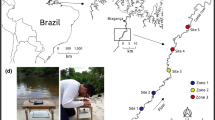Abstract
This paper is concerned with the ecological significance of variation in shell form within the thaisid gastropod genus Lepsiella in New Zealand. Shell form has been investigated by measurement of shell height and breadth, aperture length and width, the diameters of consecutive whorls, apical angle, shell weight, and shell capacity, although in many cases shell height and shell breadth could not be measured because of erosion. L.albomarginata has been studied intensively at 4 stations in the South Island, and L. scobina less intensively at 6 stations in the North and South Islands. Comparisons of pairs of characters between stations have been tested by regression analysis and analysis of covariance where appropriate. Shells of L. albomarginata are relatively taller and narrower, and have a thicker wall, at a very sheltered station (Hakahaka Bay) that at more wave-exposed stations. L. scobina (sensu stricto), characterised by the presence of spiral ribs on the shell, exhibits less striking but comparable differences in shell shape. In laboratory tests in a tidal tank the thicker-shelled L. albomarginata from a sheltered station (Hakahaka Bay in Port Underwood) was much better able to resist attack by the shore crab Hemigrapsus edwardsi than was L. albomarginata from a nearby wave-exposed station (Whites Bay, near Cape Campbell, South Island). L. scobina from both stations was resistant to attack. H. edwardsi abounds at sheltered stations, but is missing from wave-exposed rock reefs such as those at Whites Bay, so that the ability to survive encounters with shore crabs is ecologically important to L. albomarginata inhabiting sheltered stations. L. scobina occupies a lower zone on the shore, where it is probably liable to encounter other more powerful predators. Its spiral ribs probably strengthen the shell. We do not know to what extent differences in shell form and thickness depend on environmental factors, and to what extent they originate genetically. Thin shells are associated with an abundance of mussels (Mytilus edulis ssp. aoteanus or Modiolus neozelanicus). There is an interesting possibility that a scarcity of mussels or other food caused by superior nonspecific predators might result in the production of better-protected Lepsiella.
Similar content being viewed by others
Literature Cited
Bryan, G.W.: The effects of oil-spill removers (‘detergents’) on the gastropod Nucella lapillus on a rocky shore and in the laboratory. J. mar. biol. Ass. U.K. 49, 1067–1092 (1969)
Clench, W.J.: The genus Purpura and Thais in the Western Atlantic. Johnsonia 2, 61–92 (1947)
Colton, H.S.: Variation in the dog whelk, Thais (Purpura auct.) lapillus. Ecology 3, 146–157 (1922)
Ebling, F.J., J.F. Sloane, J.A. Kitching and H.M. Davies: The ecology of Lough Ine. XII the distribution and characteristics of Patella species. J. Anim. Ecol. 31, 457–470 (1962)
Feare, C.J.: Aspects of the ecology of an exposed shore population of dog-whelks Nucella lapillus (L.). Oecologia (Berl.) 5, 1–18 (1970)
Fearon, C.E.: Studies in the biology and taxonomy of the thaisid gastropod Lepsiella Iredale. Thesis for the degree of Master of Science with Honours, University of Canterbury 1962
Kincaid, T.: Local races and clines in the marine gastropod Thais lamellosa Gmelim: a population study, 75 pp. Seattle: Calliostoma Co. 1957
Kitching, J.A., L. Muntz and F.J. Ebling: The ecology of Lough Ine XV. The ecological significance of shell and body form in Nucella. J. Anim. Ecol. 35, 113–126 (1966)
Knox, G.A.: The intertidal ecology of Taylor's Mistake, Banks Peninsula. Trans. R. Soc. N.Z. 81, 189–220 (1953)
—: Problems of speciation in intertidal organisms with special reference to New Zealand shores. Publs Syst. Ass. 5, 1–199 (1963)
Largen, M.J.: The influence of water temperature upon the life of the dog-whelk Thais lapillus (Gastropoda, Prosobranchia). J. Anim. Ecol. 36. 207–214 (1967)
Luckens, P.A.: Competition and predation in shore zonation at Leigh. Ph.D. Thesis, Auckland University 1966
Moore, H.B.: The relation of shell growth to environment in Patella vulgata. Proc. malac. Soc. Lond. 21, 217–222 (1934)
—: The biology of Purpura lapillus L. Shell variation in relation to environment. J. mar. biol. Ass. U.K. 21, 61–89 (1936)
Powell, A.W.B.: Shells of New Zealand, 203 pp. Christchurch. N.Z.: Whitcombe and Tombs Ltd. 1962
Spight, T.M.: Ontogeny, environment, and shape of a marine snail Thais lamellosa Gmelin. J. exp. mar. Biol. Ecol. 13, 215–228 (1973)
Staiger, H.: Der Chromosomendimorphismus beim Prosobranchier Purpura lapillus in Beziehung zur Ökologie der Art. Chromosoma 6, 419–478 (1954)
—: Genetical and morphological variation in Purpura lapillus with respect to local and regional differentiation of population groups. Année biol. 33, 251–258 (1957)
Suter, H.: Manual of the New Zealand Mollusca, 1120 pp. Wellington, N.Z.: Government Printer 1913
Thompson, D'Arcy, W.: On growth and form, 793 pp Cambridge: University Press 1971
Author information
Authors and Affiliations
Additional information
Communicated by J.H.S. Blaxter, Oban
Rights and permissions
About this article
Cite this article
Kitching, J.A., Lockwood, J. Observations on shell form and its ecological significance in thaisid gastropods of the genus Lepsiella in New Zealand. Mar. Biol. 28, 131–144 (1974). https://doi.org/10.1007/BF00396304
Accepted:
Issue Date:
DOI: https://doi.org/10.1007/BF00396304




